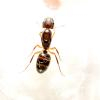Here's a good video about finding them below
Basically, when you find the swarms of males you will need to wait for the queens to show up and they come every 10-20 minutes or so based on what he found out.
https://www.google.c...147448319,d.cGw

Here's a good video about finding them below
Basically, when you find the swarms of males you will need to wait for the queens to show up and they come every 10-20 minutes or so based on what he found out.
https://www.google.c...147448319,d.cGw
Hartford, Providence and Boston all officially just hit over 70 degrees according to NWS tweet, so definitely worth keeping an eye out.
Edited by noebl1, February 24 2017 - 9:31 AM.
Since P. imparis were very active today in MA, I got some videos.
https://www.youtube....h?v=rdFVlS3tevU
This is the entire habitat of where I find them. (Methuen) About half of these trees (None of The Softwoods) have colonies or are commonly foraged on, but I am shining the light on one tree in particular.
https://www.youtube....h?v=SgQ0iFmo6gA
They group up a lot at the base of the tree and climb it , but they scale the partly broken branch that is hanging off of the tree. A lot of sap is produced off it and I often see them grouped up at the wet parts of it which is the sap.
https://www.youtube....h?v=IwazAFCKQ3k
https://www.youtube....h?v=gEG3EjUNF8U
https://www.youtube....h?v=rUyf0AsE_Vg
I hope P. imparis flies soon!
I found a P. imparis colony under wood today and it was packed with males and a couple female alates. Good to hear, you know they are ready to fly when they move the alates to the highest point in the nest.
Caught three Prenolepis Imparis Queens yesterday around 4:00pm. Was approximately 73 degrees and extremely sunny. They are all biting their gasters, is this preparation for egg laying?
Caught three Prenolepis Imparis Queens yesterday around 4:00pm. Was approximately 73 degrees and extremely sunny. They are all biting their gasters, is this preparation for egg laying?
Nice catch. I remember reading that the gaster biting is a sign of fertility (or injury, this is something from personal experience), so that's a good or bad sign. :hmm: That being said injuries are often visible.
Edited by Nathant2131, February 25 2017 - 3:48 PM.
@Bracchymyrmex I've got queen collecting envy ![]()
Patience pays off
![]() We have a chance here in MA *maybe* this Wed as temps approach 70s again. However may rain, and then it's a cold front coming thru after, so could be awhile again before we have a shot after this.
We have a chance here in MA *maybe* this Wed as temps approach 70s again. However may rain, and then it's a cold front coming thru after, so could be awhile again before we have a shot after this.
Never knew how much their color varied. It makes the first one look a lot like a Lasius queen. Stop making us anxious hehe
That might have been the lighting, don't count on em being brown.
It was definitely the lighting; I actually noticed it too.
Bracc. took some photos of the queens crawling up the walls where we caught them outside; in which they looked very bright yellow. At one point, when we were looking at the queens in out dimly-lit car, I panicked a little and thought the queens were Nylanderia flavipes (who fly soon after Prenolepis, and are closely related), but they're definitely Prenolepis. I've noticed that their apparent coloration depends greatly on the lighting; in some cases they're dark and look similar to lightly-colored Chthonolasius queens, and in some cases they're bright yellow and look almost like wasps!
Nevertheless, they've grown on me and I've definitely classified them as one of the most beautiful species out there. The workers' pigments are also very interesting; they range from a crisp amber to a rich, dark (almost reddish), brown.
Good Luck in finding some for yourself, Nate. From what I understand, they're relatively difficult to get your hands on, but definitly worth the time and effort.
Ah. Yeah, I agree P. imparis are probably the most beautiful ant out there. Will have no problem catching queens though, they are one of the most common sp where I live. Good luck on them yourself.
Never knew how much their color varied. It makes the first one look a lot like a Lasius queen. Stop making us anxious heheThat might have been the lighting, don't count on em being brown.
It was definitely the lighting; I actually noticed it too.
Bracc. took some photos of the queens crawling up the walls where we caught them outside; in which they looked very bright yellow. At one point, when we were looking at the queens in out dimly-lit car, I panicked a little and thought the queens were Nylanderia flavipes (who fly soon after Prenolepis, and are closely related), but they're definitely Prenolepis. I've noticed that their apparent coloration depends greatly on the lighting; in some cases they're dark and look similar to lightly-colored Chthonolasius queens, and in some cases they're bright yellow and look almost like wasps!
Nevertheless, they've grown on me and I've definitely classified them as one of the most beautiful species out there. The workers' pigments are also very interesting; they range from a crisp amber to a rich, dark (almost reddish), brown.
Good Luck in finding some for yourself, Nate. From what I understand, they're relatively difficult to get your hands on, but definitly worth the time and effort.
Caught another Prenolepis queen today. Was about 72° F around 2:30pm-3:00pm and we managed to find one queen in that time. Unfortunately it rained soon after and we were unable to find any more queens. High of 35° F on Saturday, many queens from this and last week will probably die. I will post a picture soon.
0 members, 1 guests, 0 anonymous users